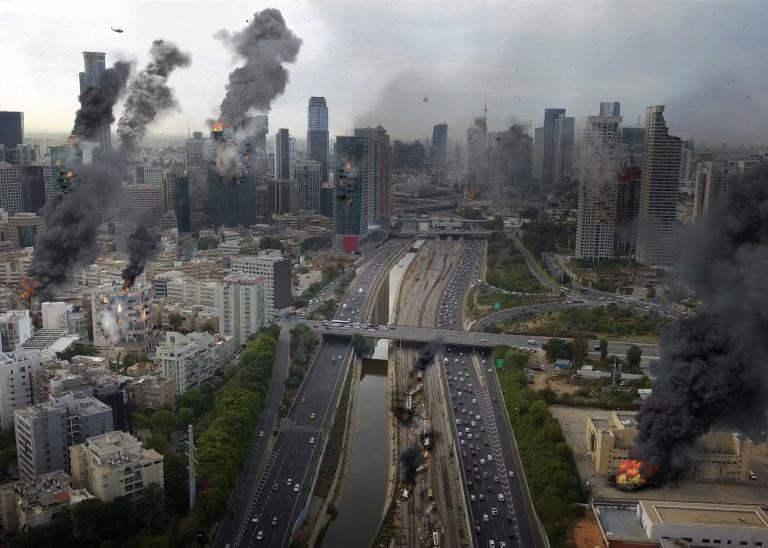14 Oct 2021 | 10:03 AM UTC
Gulf of Tonkin: TD Kompasu weakens, tracking west-northwestward Oct. 14; landfall over Thanh Hoa Province, Vietnam, late Oct. 14 /update 7
TD Kompasu weakens, tracking west-northwestward over Gulf of Tonkin Oct. 14. Landfall over Thanh Hoa Province, Vietnam, late Oct. 14.
Event
Tropical Depression Kompasu (also known as Maring in the Philippines) has weakened and is tracking west-northwestward over the Gulf of Tonkin Oct. 14 after making landfall over Boao Town, Qionghai City, China, at around 15:40 Oct. 13. As of 16:00 ICT, the storm's center of circulation was approximately 187 km (116 miles) south-southeast of Hanoi, Vietnam. Forecast models indicate the system will make another landfall as a tropical depression in Vietnam's Thanh Hoa Province late Oct. 14. After making landfall in Vietnam, Kompasu is forecast to turn to track southwestward, dissipating over Nghe An Province, Vietnam by the afternoon of Oct. 15. The storm's track and intensity forecast remain somewhat uncertain, and the system may change accordingly over the coming days.
Reports indicate that at least 14,909 people have been evacuated from Cagayan Valley, Central Luzon, Cordillera Administrative Region, Ilocos Region, and Mimaropa in the Philippines. At least 30 people have died and at least 325 houses have been damaged. In Hong Kong, at least one person has died and six others injured due to the storm.
Authorities in Vietnam are preparing to evacuate at least 250,000 people in Central Vietnam in advance of the storm.
Government Advisories
The China Meteorological Administration has issued a blue typhoon warning due to the storm, forecasting that heavy rainfall will affect the coastal areas of Guangxi and northeastern Hainan provinces as well as the Leizhou Peninsula of Guangdong Province until at least the afternoon of Oct. 15.
Vietnamese officials have warned of moderate to heavy rain of 4-7 cm (1.5-3 inches) from Thanh Hoa Province to Quang Binh Province through at least Oct. 14. Oct. 15-18, heavy rain is likely over Central Vietnam Region.
Authorities will likely issue new warnings or update existing advisories throughout the system's progression in the coming days. Weather warnings could remain active even after the system's immediate threat has diminished, as some areas may still be highly susceptible to rain-induced hazards. The possibility of localized evacuations remains possible if weather conditions prove particularly hazardous.
Hazardous Conditions
The storm may bring heavy rainfall, strong winds, and rough seas to coastal areas of far southern China and central and northern Vietnam over the coming days. Sustained heavy rainfall could trigger flooding in low-lying communities near streams, creeks, rivers, and urban areas with inadequate stormwater drainage systems.
Sites located downstream of large reservoirs could experience flash flooding after relatively short periods of intense rainfall. Rain-induced landslides are possible in steeply sloped terrains. Flooding could isolate some communities for several days. Prolonged swells and storm surge generated by the system will likely result in coastal flooding. Persistent onshore flow could make it difficult for the surge to recede and for water levels to decrease in coastal river catchments.
Transport
Inclement weather associated with the storm could trigger localized business, transport, and utility disruptions. Floodwaters and debris flows could render some bridges or roadways impassable, impacting overland travel in and around affected areas. Areal flooding in urban locations could also result in severe traffic congestion, while strong winds will pose a hazard to high-profile vehicles. Heavy rain and low visibility may trigger flight disruptions at regional airports.
Disruptions triggered by inclement weather and resultant hazards, such as flooding, could persist well after weather conditions improve. If there is severe damage to infrastructure, repair or reconstruction efforts may exacerbate residual disruptions.
Health
Stagnant pools of water during and after flooding increase the incidence of insect- and waterborne diseases, such as dengue fever, cholera, and malaria. The threat of these disease outbreaks is usually elevated in low-income or underdeveloped areas of major urban centers due to the presence of incomplete or open sewer lines. The latent threat of waterborne contaminants from inundated industrial sites cannot be discounted; exposure to raw sewage and other hazardous materials mixed with floodwaters poses a serious health threat.
Advice
Activate contingency plans in areas where officials forecast tropical storm conditions. Heed any evacuation orders that may be issued. Use extreme caution in low-lying coastal areas and near streams, creeks, and other waterways due to the potential for severe flooding and storm surge. Stockpile water, batteries, and other essentials in advance. Charge battery-powered devices when electricity is available; restrict the use of cellular phones to emergencies only. Power down mobile devices when not in use. Keep important documents and necessary medications in waterproof containers. Observe strict food and water precautions, as municipalities could issue boil-water advisories following flooding events. Take precautions against insect- and waterborne diseases in the coming weeks.
Plan accordingly for protracted commercial, transport, and logistics disruptions in areas in the path of the storm, especially if vital infrastructure is damaged. Seek updated information on road conditions before driving or routing shipments through areas where flooding has occurred. Confirm flights before checking out of hotels or driving to the airport; clearing passenger backlogs may take several days in some locations.
Resources
Joint Typhoon Warning Center
China Meteorological Administration
Vietnam National Centre for Hydro-Meteorological Forecasting (Vietnamese)


